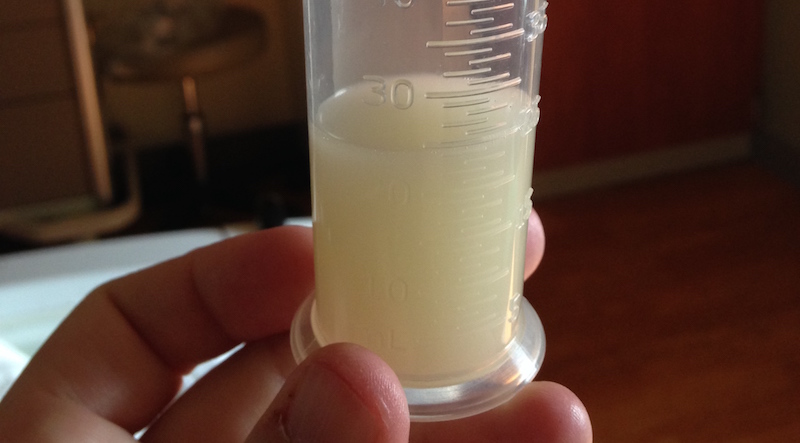Milk Supply Worries
 Milk supply worries are the worst! This isn't uncommon. Many families are worried about their breastmilk supplies. I think this comes from many places. The first place is the internet. Friend or foe, it has a lot of miss-information and people do like spreading their sad stories. I feel like it seems as if far more people struggle with breastfeeding period because we can all read about them on Facebook, Instagram, and Twitter. The fact is that you are more likely to complain about what is going poorly than crow about what is working.
Milk supply worries are the worst! This isn't uncommon. Many families are worried about their breastmilk supplies. I think this comes from many places. The first place is the internet. Friend or foe, it has a lot of miss-information and people do like spreading their sad stories. I feel like it seems as if far more people struggle with breastfeeding period because we can all read about them on Facebook, Instagram, and Twitter. The fact is that you are more likely to complain about what is going poorly than crow about what is working.
That being said, breastmilk supply worries are real and of concern.
Questions to Ask Yourself to Find Out if You Are in Trouble or Just Worrying
1
Is your baby gaining weight? For the first 3-4 days we expect babies to lose weight and then start gaining ON AVERAGE about 1 oz per 24 hours until about 16 weeks or so. At that point, we generally see weight gain slow to about 0.5 oz per 24 hours. After 9 months or so it slows to about 0.25 oz per 24 hours.
2
Is your baby having enough wet and poopy diapers? By day four, your baby is having at least 6 good, wet diapers and a total volume of poop in 24 hours that equals or exceeds 4 quarters worth (you know, coins).
3
Does your baby seems happy and content after a breast feed?
4
Are your breast gets softer during nursing?
5
Is your baby is actively feeding at the breast, not falling asleep right away?
6
Does your baby has lots of deep, slow chin drops while they are feeding?
7
Are you needing to use any banked breastmilk, donor breastmilk, or formula?
If you answered yes to questions 1-6 and no to question 7, most likely you are fine. If the answers for questions 1-6 are no and/or the answer to question 7 is yes, then you are most likely struggling a bit with your breastmilk supply.
What Are the Causes?
Why do people struggle with breastmilk supply? According to Lisa Marasco and Diana West (The Breastfeeding Mother’s Guide to Making More Milk (2010- New Edition coming soon!), there are four major factors in the breastmilk supply equation:
- Glandular tissue in the breast
- Intact nerves and ducts in the breast
- Proper hormones and receptors
- Frequent (8+ times per 24 hours), effective breastmilk removal = good breast milk production
These four factors are critical to making breastmilk but the one we have the most control over in the last one, frequent, effective breastmilk removal. Many mothers do not begin to this in the first days and often weeks after they have their babies. Most of my mothers who struggle with breastmilk production had a slow start to emptying their breasts often and effectively enough from day one.
The fact is we are not sure why breastmilk supply is an issue for many women but here are some other theories:
- Proper mammary development during adolescence is the cornerstone of building a milk factory capable of full production. How many women start their periods early or begin taking birth control pills at a young age due to painful periods?
- Environmental factors may affect hormones and receptors and alter glandular growth
- We know what happens during the birth and immediate postpartum can alter breast changes and our hormone profiles.
Here are some risk factors that seem to impact breastmilk supply:
- Lack of glandular tissue or breast development
- Hormone imbalances
- Obesity
- Diabetes
- Hormone conditions potentially affecting lactation
- Hyperandrogenism
- PCOS
- Diabetes
- Thyroid dysfunction
What Can We Do?
What can be done to help upregulate a breastmilk supply? I like to say, if you can make some breastmilk, you can probably make some more! I would strongly encourage you to work with an IBCLC for this. Making more breastmilk seems to be like preventing the common cold, different people need different things. Be careful with herbs and medications! Many can be harmful to you!
Some ideas:
1. Better milk removal
2. Better latch and positioning
- See if you can get a deeper more effective latch. If so, nurse more! Be careful though. Some people say a nursing baby always drains the breast better than a breast pump or with hand expression. If the baby is not nursing well, this is not true!
- Compress and massage your breasts while nursing. Push the breastmilk out to your baby while nursing or pumping.
- Switch sides frequently if the baby gets sleepy or fussy. Make sure the baby is getting enough calories!
- If baby is unable to latch at all or to move milk effectively then milk needs to be manually moved with a pump or by hand
3. Some breast pumping schedule ideas
Use “Hands on pumping techniques”
- Massage breasts and chest area
- Warm up breast shields
- Make sure your breast shields fit properly
- Pump for about five minutes
- Massage breasts while pumping
- Take a two minute break
- Pump and massage again
- Hand express afterwards
- How low your rate of breastmilk production is going to determine how often you need to empty and stimulate your breasts
- The lower the rate of breastmilk production is, the more extra milk removal the mother needs to do
- However, you have to have a schedule that is realistic for mother
- What if she has a baby that cries when put down?
- What if she has other children she is trying to take care of?
- Suggest some power pumps, pump for one hour 10 minutes on, 10 off, 10 on, 10 off, for 60 minutes. I don’t find this to be very realistic so I suggest 25 minutes of extra pumping, 5 minutes on, 5 minutes off, 5 minutes on, 5 minutes off, 5 minutes on
- Consider a pump like crazy day
- Set up pump somewhere and just pump for 5 minutes really frequently, every hour or so, at least 10 times during the day. Do this from about 8 AM to 8 PM. Don’t worry about keeping the milk so much as telling your body you need more breastmilk.
4. Galactagogues- Possible breastmilk increasers - These are only potentially effective if there is also good breastmilk removal!
- Foods
- Fiber- Oatmeal and quinoa
- Good omega 3 and 6 foods
- Avocado
- Coconut
- Olive oil
- Pumpkin seeds
- Wild caught salmon
- Probiotics- Good gut health
- Herbal supplements- Please get expert help before trying these herbs! Many have negative side effects depending on the health of the mother
- Fenugreek
- Shatavari
- Goat’s Rue
- Malunggay or Moringa
- Medications:
- Reglan (Metoclopramide)
- Suggested dose: 10 mg 3 times per day for 1 week, then twice a day for 1 week, then once a day for 1 week- Strongly suggested tapering off!
- 8 studies all saw positive results, higher prolactin levels
- Crosses blood brain barrier- May cause PPD or exacerbate it
- Domperidone http://www.ijgo.org/article/S0020-7292%2811%2900593-5/abstract
- Raises prolactin levels. Suggested dose: 10-20 mg 3 times per day, follow same tapering as Reglan- However, Jack Newman suggests higher doses.
- Contraindicated with heart issues
- Large clinical trials need to be done
- Chiropractic and acupuncture - Some people find this helps balance their hormones and improve their nerve connections http://www.acupunctureinmichigan.com/blog/how-can-acupuncture-benefit-breastfeeding/
- Reglan (Metoclopramide)
